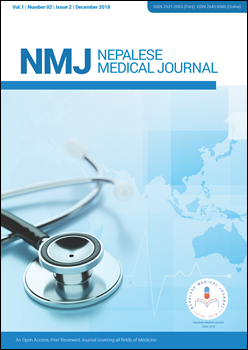Antimicrobial Resistance Patterns in Clinical Isolates of Enterobacteriaceae from a Tertiary Care Hospital, Kathmandu, Nepal
DOI:
https://doi.org/10.3126/nmj.v1i2.21578Keywords:
Enterobacteriaceae, ESBL, MDRAbstract
Introduction: Multidrug resistance among Enterobacteriaceae is in increasing trend these days. The objective of this study was to determine the antibiogram of clinical isolates of Enterobacteriaceae with special reference to multidrug resistance and extended spectrum beta-lactamases production.
Materials and Methods: A descriptive cross sectional study was conducted over a period of six months (February -July, 2017) in the microbiology laboratory of Nepal Medical College Teaching Hospital, Kathmandu, Nepal. A total of 936 bacterial isolates of Enterobacteriaceae from clinical specimens were processed for antimicrobial susceptibility testing and screened for multidrug resistance. ESBL production was detected among potential isolates by combination disk diffusion test.
Results: The rate of multidrug resistance and extended spectrum beta-lactamases production was 54.2% and 23.8% respectively. Of the total ESBL producers 92.4% were multidrug resistance. The rate of multidrug resistance and extended spectrum beta-lactamases production were higher in organisms isolated from clinical samples collected from inpatients. High rate of multidrug resistance and extended spectrum beta-lactamases production was seen in E. coli (54.4% & 27.7%), Klebsiella spp. (67.1% & 28.2%) and Citrobacter spp. (70.3% & 10.9%). The antimicrobial resistance rate was highest against ampicillin (76.7%) followed by cefixime (54. 0%), ceftazidime (51.5%), ceftriaxone (51.0%), cotrimoxazole (48.7%), ciprofloxacin (43.9%) and ofloxacin (41.1%).
Conclusions: Multidrug resistance is common among Enterobacteriaceae. These bacteria have high rate of resistance against commonly used groups of antibiotics like cephalosporins and quinolones. Continuous monitoring, surveillance of antimicrobial resistance, proper infection control and practices are important to combat with these issues.
Downloads
Downloads
Published
How to Cite
Issue
Section
License
This license enables reusers to distribute, remix, adapt, and build upon the material in any medium or format, so long as attribution is given to the creator. The license allows for commercial use.
Copyright on any article published by Nepalese Medical Journal is retained by the author(s).
Authors grant Nepalese Medical Journal a license to publish the article and identify itself as the original publisher.
Authors also grant any third party the right to use the article freely as long as its integrity is maintained and its original authors, citation details and publisher are identified.




